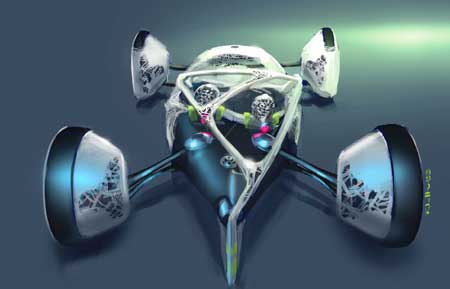 Many concept vehicles are really glimpses at future products that are already in the pipeline. That’s good and all, but sometimes, it’s fun to see what happens when designers are given no physical constraints and let their imaginations take over. The Volkswagen Nanospyder revealed in illustrations earlier this week is that sort of concept. Totally far-out, ripped from the pages of a sci-fi novel. The design was created for the ‘Design Los Angeles” conference that’ll be held later this month at the L.A. Auto Show. The mission was to come up with something that would “make the most of California” without harming the Golden State’s environment.
Many concept vehicles are really glimpses at future products that are already in the pipeline. That’s good and all, but sometimes, it’s fun to see what happens when designers are given no physical constraints and let their imaginations take over. The Volkswagen Nanospyder revealed in illustrations earlier this week is that sort of concept. Totally far-out, ripped from the pages of a sci-fi novel. The design was created for the ‘Design Los Angeles” conference that’ll be held later this month at the L.A. Auto Show. The mission was to come up with something that would “make the most of California” without harming the Golden State’s environment.
Since it’s for California, the trio of designers from VW’s Design Center in Santa Monica made the car a spyder — after all, open-top motoring is a natural fit, right? And it’s clean-running, powered by a hydrogen fuel cell that deives wheel-mounted electric motors. From there, however, it’s anything but conventional. The car is (theoretically) built on a latticework frame that’s made up programmable nanodevices with adjustable rigidity. Said nanotechnology allows certain sections of the car to be stiffer (it’s “spine,” for example) while allowiong other areas, such as active crumple zones, to offer more flexibility. The lattice is skinned in an organic material that helps synthesize energy to feed the car’s powertrain.
Fascinating idea, and it’s all in a very futuristic-looking package that still communicates the sportiness you associate with the “spyder” moniker.

PRESS RELEASE: VOLKSWAGEN DESIGNERS CREATE FUTURISTIC NANOSPYDER CONCEPT
A team of highly creative Volkswagen designers based in California have unveiled their own unique take on the future of modern transportation.
The result is the Volkswagen Nanospyder. Futuristic nanotechnology supported by hydrogen fuel cells, solar power, wheel-mounted electric motors and inflatable organic body panels combine to form the unusual shape of the two-seater concept.
Nanospyder is the work of a team of three young designers – Patrick Faulwetter, Daniel Simon and Ian Hilton – based at the Volkswagen Design Center in Santa Monica. They created the Nanospyder in response to a challenge laid down by ‘Design Los Angeles’, a conference set to take place at the upcoming Los Angeles Motorshow in November. The brief – unlike the solution – was simple. To design a vehicle able to make the most of California without harming the environment.
The team met its brief by thinking well beyond current manufacturing techniques. According to its creators the Nanospyder would be formed out of a latticework of billions of tiny programmable nano devices measuring less than half a millimetre in diameter. Each of these tiny devices can be programmed to be as strong or weak as required meaning active crumple zones can be created. The ‘spine’ of the vehicle, onto which the rest of the components are attached, remains immensely strong.
Clothing the nano-lattice are panels formed out of a mix of organic materials some of which can inflate to provide further cushioning in the result of an impact. The material doubles as a power source as polysynthesis generates small amounts of electricity. This coupled with hydrogen fuels generates power to drive the tiny electric motors mounted within the hubs of all four wheels.

The Nanospyder, although purely intended as a concept vehicle, gives an insight into the depth of thinking going into the search for sustainable forms of modern transport.
The concept was created to be entered in the third Los Angeles Design challenge – the winner of which will be announced on November 30th at the Los Angeles Motorshow.
The Volkswagen studios, established in 1991, won the very first challenge in 2005 with the innovative Mobile Lounge concept. [VW]
